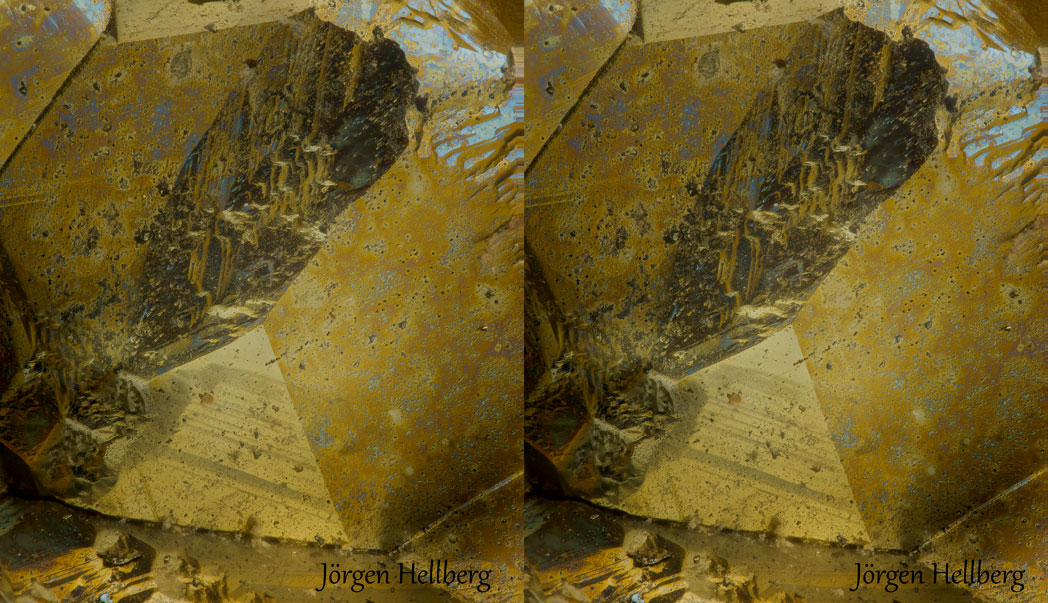Choosing software for Focus Stacking – Step one speed
These results are with the AMD Ryzen 7 3700X Processor with 8 cores / 16 threads and the ASUS ROG STRIX B450-F motherboard. The internal hard drive is a 1 TB Kingston’s A2000 NVMe PCIe SSD. Other combinations will have different measured speeds. These results are with the Bios settings at “Normal”. I tried to have the same options for every test. I was only running the stacking program but as is well known there are a lot of processes running automatically on a computer. Repeating the tests therefore can give slightly different results.
Hardware acceleration in Helicon Focus

Helicon Focus can use OpenCL hardware acceleration. For this test I have used my old GeForce GTX 980. Using hardware acceleration can significantly speed up the stacking process but is not necessary.
Example 1 – a medium stack
The first set is this picture of three pollen grains. The stack consists of 102 JPG photos 3MB each.
Helicon Focus 7 – method C
After, loading the set and then stacked them using method C I measured a 21 second stacking time or more than 5 photos per second. I could not with any significance measure a difference between having the pictures on the hard drive or on the external drive. I choose method C because it is the method that is most comparable to one of Zerene Stacker methods – PMax. Helicons other methods was almost identically fast.
With hardware acceleration I measured a little less than 9 seconds stacking time or approximately 12 photos per second.
Zerene Stacker – PMax
After loading the pictures in Zerene Stacker, stacking them using PMax I measured 2 minutes and 41 seconds stacking time or more than 0.7 photos per second. I could not with any significance measure a difference between having the pictures on the hard drive or on the external drive.

Example 2 – 849 TIFF images
More pictures use more computer time to stack, so for large stacks time is more important. The second example is the photos I used to make the crossed eye stereo of the pyrite mineral above. The stack consists of 849 TIFF photos 114MB each. Because the stacking programs have differences in how they handle the pictures I wanted to time the entire process from loading the pictures to final stack. I started the timer when the program started to load the photos and stopped the timer when the picture was ready.
Helicon Focus 7 – method C
It took 4 minutes and 43 seconds with the pictures on the internal drive. This is approximately 3 pictures per second. When the pictures were on the external drive it took 10 minutes and 47 seconds. This is approximately 1,3 pictured per second.
With hardware acceleration and having the 849 photos on the PCIe SSD internal hard drive I measured 1 minute and 43 seconds. This is approximately 8 pictures per second. Having the photos on the USB 3 external drive did not increase the stacking speed.
Zerene Stacker – PMax
It took 21 minutes and 10 seconds with the pictures on the internal drive. This is a little more than 0.7 pictures per second and consistent with what was measured in example 1 above. With the external drive I measured 21 minutes and 31 seconds, this could be due to some normal variation or be a small but not significant increase in speed using the internal hard drive.
Some conclusions
Helicon Focus is faster than Zerene Stacker. For a medium stack of 102 JPG photos Helicon Focus stacks 5 to 12 photos per second, Zerne Stacker 0.7 photos per second. For a large stack of 849 TIFF photos Helicon stacks 1.3 to 8 photos per second and Zerne Stacker 0.7 photos per second.
It is obvious that Helicon Focus gains from using hardware acceleration and having the photos on a fast-internal hard drive. Zerene Stacker does not change its performance significantly using a fast-internal drive for the photos.
I use both Helicon Focus and Zerene Stacker and intend to continue to do so. When speed is important, I tend to use Helicon Focus. In other cases, such as making a stereo picture of a transparent subject I use Zerene Stacker.
The cross eyed stereo picture above of a pyrite with reflections in the prisms could not have been done in Helicon and was well worth the time it took stacking in Zerene Stacker.
A Zerene Stacker tip – I saved 6 minutes
Using Zerene Stacker there are some settings that can speed up the (first) stack. Zerenen caches pictures of the unaligned and the aligned screen images. This affects the time it takes for Zerene to do the first stack. The cached images make retouching a little faster. The options are “Cache unaligned screen images” and “Cache aligned screen images”. Uncheck these two options if you want the stacking to be done a little faster. They can be found under “Preferences/-Miscellaneous/Caching & Undo”.
There is also a setting that “Set output display interval when stacking” that can be set to some time for example 30 seconds. This decides how fast the stacked image is refreshed. This setting can be found under “Preferences/-Miscellaneous/Look & Feel”.
Unchecking the caching and setting the interval to 30 seconds changed the stacking time in Example 2 above from 21 minutes and 10 seconds to 15 minutes and 15 seconds.


